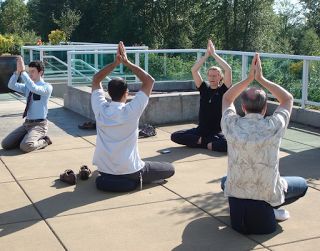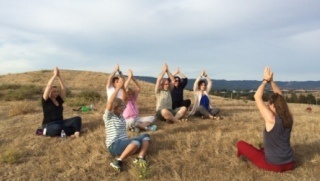Taoist Meditation and Qigong
What Is Qigong?
The word Qigong combines two Chinese words:
Qi, pronounced chee, is usually translated to mean the life force that flows through all things in the universe. It is that vital energy that makes life exciting, fun, creative, and joyful. Instinctively we know that the more energy we have, the better we feel.
Gong, pronounced gung, means accomplishment or skill cultivated through steady practice. The subtle skill of breath control is one of the keys to circulating the flow of internal energy in the body.
Thus the term Qigong may be translated as cultivating energy, as well as breathing exercise. Regular qigong practice cultivates our connection with our life force energy.
Qigong is an ancient Chinese healthcare system developed to reduce tension and improve health.
It integrates:
- ✨ physical postures, moving or stationary
- ✨ breathing techniques
- ✨ focused intention
Although qigong is based in Taoism, it is not necessary to learn or believe Taoist philosophy to benefit from or practice qigong. People of all ages, life circumstances and spiritual and religious persuasions enjoy qigong.
What physical benefits may arise from practicing the intentional and gentle movements of qigong?
- ✨ reduce stress, build stamina, increase vitality, and enhance the immune system
- ✨ improve cardiovascular, respiratory, circulatory, lymphatic and digestive functions
- ✨ decrease chronic muscle and joint pain
- ✨ regain and maintain youthful vitality, promote balance, and help speed recovery from illness
What other benefits arise from practicing qigong?
One important long-term effect is that qigong reestablishes the body/mind/soul connection.
People practice qigong to support general health, heal their bodies, calm their minds, and reconnect with their spirits. Regular practice of qigong cultivates harmony, emotional stability, inner tranquility, and enjoyment of life while at the same time may reduce stress, anger, anxiety, depression, and rumination.
What Is Taoist Meditation?
Taoist meditation leads to inner harmony by blending our personal energy with Universal energy. This combined spiritual energy then circulates through our physical bodies. This meditation style encompasses both stillness and movement guided by our inner wisdom.
It acknowledges that all beings experience suffering, but rather than focus on the suffering, it teaches us to work with our higher self to transcend suffering and reach a place of joy and lightheartedness.
The style of Taoist meditation I teach is Sum Faht®. It helps us connect with and activate the divine energies of the heart. It combines traditional seated meditation in stillness with standing, walking and guided movements through which we integrate mind, body and spirit.
This form of meditation encourages us to simply be—who we are, as we are. Rather than attending to the mind, we focus on the energy center in the middle of our bodies, two finger-widths below our navel, known as the tan tien. As we surrender and deepen our self-acceptance, we begin to cultivate a relationship with our inner self. Sometimes through this awareness of or confrontation of self, we find anger, frustration, sadness, or unresolved conflicts.
Taoist meditation helps these feelings to surface. Facing, honoring, and embracing these feelings frees our energy and may lead not only to greater peace and joy but health and vitality.
What Can I Expect During Class?
The class consists of 3 components:
- ✨ Gentle flowing warm-up exercises
- ✨ One of a variety of standing movement forms, this changes every few months
- ✨ A seated mudra series I developed with the intention of cultivating compassion
Wear loose, comfortable clothing, and be prepared to stand, move, and sit.
Learn more about qigong and the benefits of this practice in these articles.
Yi Jin Jing for Vitality: This is a one-day workshop that teaches this ancient series, which focuses on infusing soft tissue with qi.
Deep Breathing & Qigong Reduce Anxiety: An informative article on how to use qigong and breathing as an effective stress reduction too; this article includes two easy-to-implement qigong and breathing exercises.
Embodied Mindfulness Harmonizes Mind & Body: Qigong is an example of an embodied mindfulness practice. It is shown to reduce stress, anxiety, and depression; this article also includes an easy-to-implement qigong exercise.
About Amy Pattee Colvin
I first began practicing Taoist-based compassion meditation in the mid-1990s. The movement and energy-oriented components of this style of meditation were especially attractive to me. Rather than being expected to sit in stillness, we learned to connect our internal wisdom and internal energy (qi), and through the process of harmonizing with that energy, movement arises.
My teacher, Leong Tan, developed multiple qigong forms for his students, which I’m pleased to share with you, as well as a modified version of the ancient form called Yi Jin Jing.
Please contact me with any questions you may have about qigong and the classes I offer.




